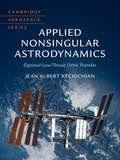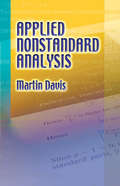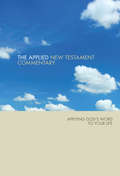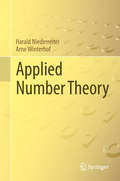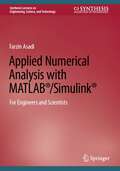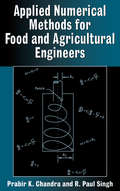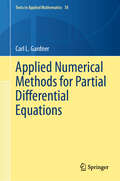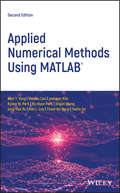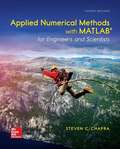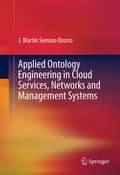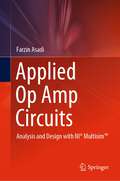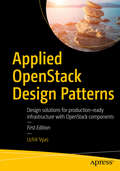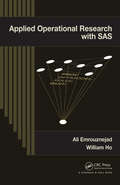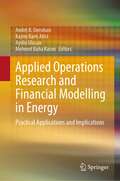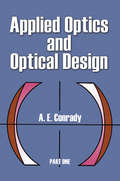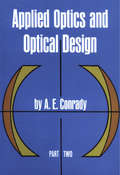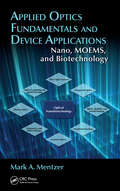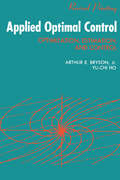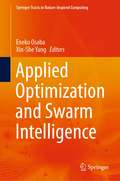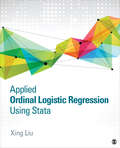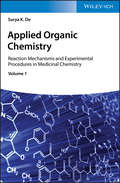- Table View
- List View
Applied Nonsingular Astrodynamics: Optimal Low-Thrust Orbit Transfer (Cambridge Aerospace Series #45)
by Jean Albert KéchichianThis essential book describes the mathematical formulations and subsequent computer simulations required to accurately project the trajectory of spacecraft and rockets in space, using the formalism of optimal control for minimum-time transfer in general elliptic orbit. The material will aid research students in aerospace engineering, as well as practitioners in the field of spaceflight dynamics, in developing simulation software to carry out trade studies useful in vehicle and mission design. It will teach readers to develop flight software for operational applications in autonomous mode, so to actually transfer space vehicles from one orbit to another. The practical, real-life applications discussed will give readers a clear understanding of the mathematics of orbit transfer, allow them to develop their own operational software to fly missions, and to use the contents as a research tool to carry out even more complex analyses.
Applied Nonstandard Analysis
by Prof. Martin DavisGeared toward upper-level undergraduates and graduate students, this text explores the applications of nonstandard analysis without assuming any knowledge of mathematical logic. It develops the key techniques of nonstandard analysis at the outset from a single, powerful construction; then, beginning with a nonstandard construction of the real number system, it leads students through a nonstandard treatment of the basic topics of elementary real analysis, topological spaces, and Hilbert space.Important topics include nonstandard treatments of equicontinuity, nonmeasurable sets, and the existence of Haar measure. The focus on compact operators on a Hilbert space includes the Bernstein-Robinson theorem on invariant subspaces, which was first proved with nonstandard methods. Ever mindful of the needs of readers with little background in these subjects, the text offers a straightforward treatment that provides a strong foundation for advanced studies of analysis
Applied NT Bible Commentary
by Tom Hale Steve ThorsonThe wisdom found in God's Word is timeless, as relevant today as when it was first written. And the challenge for believers remains unchanged: how do we apply these truths to our everyday world?The Applied Commentary series is a fresh approach to Bible study, connecting great wisdom with your life today. Each Scripture passage is enhanced with insights on key themes and ideas. Featured articles provide a deeper look at essential concepts, while the contemporary language allows for easy reading. And because some subjects are open to interpretation for discussion, we've included perspectives from leading theologians from all backgrounds and denominations. The result?An interactive approach to Scripture that will challenge your ideas and build your faith--which is what reading the Bible is all about.
Applied Number Theory
by Arne Winterhof Harald NiederreiterThis textbook effectively builds a bridge from basic number theory to recent advances in applied number theory. It presents the first unified account of the four major areas of application where number theory plays a fundamental role, namely cryptography, coding theory, quasi-Monte Carlo methods, and pseudorandom number generation, allowing the authors to delineate the manifold links and interrelations between these areas. Number theory, which Carl-Friedrich Gauss famously dubbed the queen of mathematics, has always been considered a very beautiful field of mathematics, producing lovely results and elegant proofs. While only very few real-life applications were known in the past, today number theory can be found in everyday life: in supermarket bar code scanners, in our cars' GPS systems, in online banking, etc. Starting with a brief introductory course on number theory in Chapter 1, which makes the book more accessible for undergraduates, the authors describe the four main application areas in Chapters 2-5 and offer a glimpse of advanced results that are presented without proofs and require more advanced mathematical skills. In the last chapter they review several further applications of number theory, ranging from check-digit systems to quantum computation and the organization of raster-graphics memory. Upper-level undergraduates, graduates and researchers in the field of number theory will find this book to be a valuable resource.
Applied Numerical Analysis with MATLAB®/Simulink®: For Engineers and Scientists (Synthesis Lectures on Engineering, Science, and Technology)
by Farzin AsadiThis textbook provides a compact but comprehensive treatment that guides students through applied numerical analysis, using MATLAB®/Simulink®. Ideal as a hands-on source for courses in Numerical Analysis, this text focuses on solving problems using market-standard software, corresponding to all key concepts covered in the classroom. The author uses his extensive classroom experience to guide students toward deeper understanding of key concepts, while they gain facility with software they will need to master for later studies and practical use in their engineering careers.
Applied Numerical Methods for Food and Agricultural Engineers
by Prabir K. Chandra R. Paul SinghWritten from the expertise of an agricultural engineering background, this exciting new book presents the most useful numerical methods and their complete program listings.
Applied Numerical Methods for Partial Differential Equations (Texts in Applied Mathematics #78)
by Carl L. GardnerThe aim of this book is to quickly elevate students to a proficiency level where they can solve linear and nonlinear partial differential equations using state-of-the-art numerical methods. It covers numerous topics typically absent in introductory texts on ODEs and PDEs, including: Computing solutions to chaotic dynamical systems with TRBDF2 Simulating the nonlinear diffusion equation with TRBDF2 Applying Newton’s method and GMRES to the nonlinear Laplace equation Analyzing gas dynamics with WENO3 (1D Riemann problems and 2D supersonic jets) Modeling the drift-diffusion equations with TRBDF2 and PCG Solving the classical hydrodynamic model (electro-gas dynamics) with WENO3 and TRBDF2 The book features 34 original MATLAB programs illustrating each numerical method and includes 93 problems that confirm results discussed in the text and explore new directions. Additionally, it suggests eight semester-long projects. This comprehensive text can serve as the basis for a one-semester graduate course on the numerical solution of partial differential equations, or, with some advanced material omitted, for a one-semester junior/senior or graduate course on the numerical solution of ordinary and partial differential equations. The topics and programs will be of interest to applied mathematicians, engineers, physicists, biologists, chemists, and more.
Applied Numerical Methods Using MATLAB
by Won Y. Yang Wenwu Cao Jaekwon Kim Kyung W. Park Ho-Hyun Park Jingon Joung Jong-Suk Ro Han L. Lee Cheol-Ho Hong Taeho ImThis new edition provides an updated approach for students, engineers, and researchers to apply numerical methods for solving problems using MATLAB® This accessible book makes use of MATLAB® software to teach the fundamental concepts for applying numerical methods to solve practical engineering and/or science problems. It presents programs in a complete form so that readers can run them instantly with no programming skill, allowing them to focus on understanding the mathematical manipulation process and making interpretations of the results. Applied Numerical Methods Using MATLAB®, Second Edition begins with an introduction to MATLAB usage and computational errors, covering everything from input/output of data, to various kinds of computing errors, and on to parameter sharing and passing, and more. The system of linear equations is covered next, followed by a chapter on the interpolation by Lagrange polynomial. The next sections look at interpolation and curve fitting, nonlinear equations, numerical differentiation/integration, ordinary differential equations, and optimization. Numerous methods such as the Simpson, Euler, Heun, Runge-kutta, Golden Search, Nelder-Mead, and more are all covered in those chapters. The eighth chapter provides readers with matrices and Eigenvalues and Eigenvectors. The book finishes with a complete overview of differential equations. Provides examples and problems of solving electronic circuits and neural networks Includes new sections on adaptive filters, recursive least-squares estimation, Bairstow's method for a polynomial equation, and more Explains Mixed Integer Linear Programing (MILP) and DOA (Direction of Arrival) estimation with eigenvectors Aimed at students who do not like and/or do not have time to derive and prove mathematical results Applied Numerical Methods Using MATLAB®, Second Edition is an excellent text for students who wish to develop their problem-solving capability without being involved in details about the MATLAB codes. It will also be useful to those who want to delve deeper into understanding underlying algorithms and equations.
Applied Numerical Methods with MATLAB for Engineers and Scientists
by Steven C. ChapraApplied Numerical Methods with MATLAB is written for students who want to learn and apply numerical methods in order to solve problems in engineering and science. As such, the methods are motivated by problems rather than by mathematics. That said, sufficient theory is provided so that students come away with insight into the techniques and their shortcomings. McGraw-Hill's Connect, is also available as an optional, add on item. Connect is the only integrated learning system that empowers students by continuously adapting to deliver precisely what they need, when they need it, how they need it, so that class time is more effective. Connect allows the professor to assign homework, quizzes, and tests easily and automatically grades and records the scores of the student's work. Problems are randomized to prevent sharing of answers an may also have a "multi-step solution" which helps move the students' learning along if they experience difficulty.
Applied Ontology Engineering in Cloud Services, Networks and Management Systems
by J. Martin SerranoMetadata standards in today's ICT sector are proliferating at unprecedented levels, while automated information management systems collect and process exponentially increasing quantities of data. With interoperability and knowledge exchange identified as a core challenge in the sector, this book examines the role ontology engineering can play in providing solutions to the problems of information interoperability and linked data. At the same time as introducing basic concepts of ontology engineering, the book discusses methodological approaches to formal representation of data and information models, thus facilitating information interoperability between heterogeneous, complex and distributed communication systems. In doing so, the text advocates the advantages of using ontology engineering in telecommunications systems. In addition, it offers a wealth of guidance and best-practice techniques for instances in which ontology engineering is applied in cloud services, computer networks and management systems. Engineering and computer science professionals (infrastructure architects, software developers, service designers, infrastructure operators, engineers, etc.) are today confronted as never before with the challenge of convergence in software solutions and technology. This book will help them respond creatively to what is sure to be a period of rapid development.
Applied Op Amp Circuits: Analysis and Design with NI® Multisim™
by Farzin AsadiThis book provides a compact but comprehensive treatment that guides the reader through the important applications of operational amplifiers. The author uses his extensive classroom experience to guide readers toward a deeper understanding of key concepts of operational amplifier circuits. The NI® Multisim™ is used throughout the book to analyze and design the circuits. The book is designed to serve as a textbook for courses offered to undergraduate and postgraduate students enrolled in electrical and computer engineering. The prerequisite for this book is a first course in electric circuits.
Applied OpenStack Design Patterns: Design solutions for production-ready infrastructure with OpenStack components
by Uchit VyasLearn practical and applied OpenStack cloud design solutions to gain maximum control over your infrastructure. You will achieve a complete controlled and customizable platform. Applied OpenStack Design Patterns teaches you how to map your application flow once you set up components and architectural design patterns. Also covered is storage management and computing to map user requests and allocations. Best practices of High Availability and Native Cluster Management are included. Solutions are presented to network components of OpenStack and to reduce latency and enable faster communication gateways between components of OpenStack and native applications. What You Will Learn: Design a modern cloud infrastructure Solve complex infrastructure application problems Understand OpenStack cloud infrastructure components Adopt a business impact analysis to support existing/new cloud infrastructure Use specific components to integrate an existing tool-chain set to gain agility and a quick, continuous delivery model Who This Book Is For: Seasoned solution architects, DevOps, and system engineers and analysts
Applied Operational Research with SAS
by Ali Emrouznejad William HoUsing a wide range of operational research (OR) optimization examples, Applied Operational Research with SAS demonstrates how the OR procedures in SAS work. The book is one of the first to extensively cover the application of SAS procedures to OR problems, such as single criterion optimization, project management decisions, printed circuit board as
Applied Operations Research and Financial Modelling in Energy: Practical Applications and Implications
by Mehmet Baha Karan André B. Dorsman Kazim Baris Atici Aydin UlucanThis book on Applied Operations Research and Financial Modelling in Energy (AORFME) presents several applications of operations research (OR) and financial modelling. The contributions by a group of OR and Finance researchers focus on a variety of energy decisions, presenting a quantitative perspective, and providing policy implications of the proposed or applied methodologies. The content is divided into three main parts: Applied OR I: Optimization Approaches, Applied OR II: Forecasting Approaches and Financial Modelling: Impacts of Energy Policies and Developments in Energy Markets. The book appeals to scholars in economics, finance and operations research, and to practitioners working in the energy sector. This is the eighth volume in a series of books on energy organized by the Centre for Energy and Value Issues (CEVI). For this volume, CEVI collaborated with Hacettepe University’s Energy Markets Research and Application Center. The previous volumes in the series are: Financial Aspects in Energy (2011), Energy Economics and Financial Markets (2012), Perspectives on Energy Risk (2014), Energy Technology and Valuation Issues (2015), Energy and Finance (2016), Energy Economy, Finance and Geostrategy (2018), and Financial Implications of Regulations in the Energy Industry (2020).
Applied Optics and Optical Design, Part One
by A. E. Conrady"For the optical engineer it is an indispensable work." -- Journal, Optical Society of America"As a practical guide this book has no rival." -- Transactions, Optical Society"A noteworthy contribution," -- Nature (London)Part I covers allordinary ray-tracing methods, together with the complete theory of primary aberrations and as much of higher aberration as is needed for the design of telescopes, low-power microscopes and simple optical systems. Chapters: Fundamental Equations, Spherical Aberration, Physical Aspect of Optical Images, Chromatic Aberration, Design of Achromatic Object-Glasses, The Optical Sine Theorem, Trigonometric Tracing of Oblique Pencils, General Theory of Perfect Optical Systems, and Ordinary Eyepieces.Part II extends the coverage to the systematic study and design of practically all types of optical systems, with special attention to high-power microscope objectives and anastigmatic photographic objectives. Edited and completed from the author s manuscript by Rudolf Kingslake, Director of Optical Design, Eastman Kodak Company. Chapters: Additional Solutions by the Thin-Lens Method , Optical Path Differences, Optical Path Differences at an Axiallmage Point, Optical Tolerances, Chromatic Aberration as an Optical Path Difference, The Matching Principle and the Design of Microscope Objectives, Primary Aberrations of Oblique Pencils, Analytical Solutions for Simple Systems with Remote Stop, Symmetrical Photographic Objectives, and Unsymmetrical Photographic Objectives.
Applied Optics and Optical Design, Part Two (Dover Books on Physics)
by A. E. Conrady"For the optical engineer it is an indispensable work." -- Journal, Optical Society of America"As a practical guide this book has no rival." -- Transactions, Optical Society"A noteworthy contribution," -- Nature (London)This two-volume paperback republication of A. E. Conrady's classic work presents his complete system of optical design. The only work of its kind in English, this set leads the reader step by step from the fundamental concepts of geometrical and physical optics up to the point where he can design the simpler optical systems without aid. It remains the only detailed work on the subject written with the needs of the practical designer and the self-taught constantly in mind. For most of the text, no mathematics above trigonometry is needed; occasional sections require some calculus and analytical geometry.Part I covers all ordinary ray-tracing methods, together with the complete theory of primary aberrations and as much of higher aberration as is needed for the design of telescopes, low-power microscopes and simple optical systems. Chapters: Fundamental Equations, Spherical Aberration, Physical Aspect of Optical Images, Chromatic Aberration, Design of Achromatic Object-Glasses, Extra-Axial Image Points, The Optical Sine Theorem, Trigonometric Tracing of Oblique Pencils, General Theory of Perfect Optical Systems, and Ordinary Eyepieces.Part II extends the coverage to the systematic study and design of practically all types of optical systems, with special attention to high-power microscope objectives and anastigmatic photographic objectives. Edited and completed from the author's manuscript by Rudolf Kingslake, Director of Optical Design, Eastman Kodak Company. Chapters: Additional Solutions by the Thin-Lens Method, Optical Path Differences, Optical Path Differences at an Axial Image Point, Optical Tolerances, Chromatic Aberration as an Optical Path Difference, The Matching Principle and the Design of Microscope Objectives, Primary Aberrations of Oblique Pencils, Analytical Solutions for Simple Systems with Remote Stop, Symmetrical Photographic Objectives, and Unsymmetrical Photographic Objectives.
Applied Optics Fundamentals and Device Applications: Nano, MOEMS, and Biotechnology
by Mark A. MentzerHow does the field of optical engineering impact biotechnology? Perhaps for the first time, Applied Optics Fundamentals and Device Applications: Nano, MOEMS, and Biotechnology answers that question directly by integrating coverage of the many disciplines and applications involved in optical engineering, and then examining their applications in nanobiotechnology. Written by a senior U.S. Army research scientist and pioneer in the field of optical engineering, this book addresses the exponential growth in materials, applications, and cross-functional relevance of the many convergent disciplines making optical engineering possible, including nanotechnology, MEMS, (MOEMS), and biotechnology. Integrates Coverage of MOEMS, Optics, and Nanobiotechnology—and Their Market Applications Providing an unprecedented interdisciplinary perspective of optics technology, this book describes everything from core principles and fundamental relationships, to emerging technologies and practical application of devices and systems—including fiber-optic sensors, integrated and electro-optics, and specialized military applications. The author places special emphasis on: Fiber sensor systems Electro-optics and acousto-optics Optical computing and signal processing Optical device performance Thin film magnetic memory MEMS, MOEMS, nano- and bionanotechnologies Optical diagnostics and imaging Integrated optics Design constraints for materials, manufacturing, and application space Bridging the technology gaps between interrelated fields, this reference is a powerful tool for students, engineers and scientists in the electrical, chemical, mechanical, biological, aerospace, materials, and optics fields. Its value also extends to applied physicists and professionals interested in the relationships between emerging technologies and cross-disciplinary opportunities. Author Mark A. Mentzer is a pioneer in the field of optical engineering. He is a senior research scientist at the U.S. Army Research Laboratory in Maryland. Much of his current work involves extending the fields of optical engineering and solid state physics into the realm of biochemistry and molecular biology, as well as structured research in biophotonics.
Applied Optimal Control: Optimization, Estimation and Control
by A. E. BrysonThis best-selling text focuses on the analysis and design of complicated dynamics systems. CHOICE called it ""a high-level, concise book that could well be used as a reference by engineers, applied mathematicians, and undergraduates. The format is good, the presentation clear, the diagrams instructive, the examples and problems helpful...References and a multiple-choice examination are included.
Applied Optimization and Swarm Intelligence (Springer Tracts in Nature-Inspired Computing)
by Eneko Osaba Xin-She YangThis book gravitates on the prominent theories and recent developments of swarm intelligence methods, and their application in both synthetic and real-world optimization problems. The special interest will be placed in those algorithmic variants where biological processes observed in nature have underpinned the core operators underlying their search mechanisms. In other words, the book centers its attention on swarm intelligence and nature-inspired methods for efficient optimization and problem solving. The content of this book unleashes a great opportunity for researchers, lecturers and practitioners interested in swarm intelligence, optimization problems and artificial intelligence.
Applied Optimization in the Petroleum Industry
by Hesham K. AlfaresThe book addresses optimization in the petroleum industry from a practical, large-scale-application-oriented point of view. The models and techniques presented help to optimize the limited resources in the industry in order to maximize economic benefits, ensure operational safety, and reduce environmental impact. The book discusses several important real-life applications of optimization in the petroleum industry, ranging from the scheduling of personnel time to the blending of gasoline. It covers a wide spectrum of relevant activities, including drilling, producing, maintenance, and distribution. The text begins with an introductory overview of the petroleum industry and then of optimization models and techniques. The main body of the book details a variety of applications of optimization models and techniques within the petroleum industry.Applied Optimization in the Petroleum Industry helps readers to find effective optimization-based solutions to their own practical problems in a large and important industrial sector, still the main source of the world’s energy and the source of raw materials for a wide variety of industrial and consumer products.
Applied Optimization Methods for Wireless Networks
by Y. Thomas Hou Yi Shi Hanif D. SheraliWritten in a unique style, this book is a valuable resource for faculty, graduate students, and researchers in the communications and networking area whose work interfaces with optimization. It teaches you how various optimization methods can be applied to solve complex problems in wireless networks. Each chapter reviews a specific optimization method and then demonstrates how to apply the theory in practice through a detailed case study taken from state-of-the-art research. You will learn various tips and step-by-step instructions for developing optimization models, reformulations, and transformations, particularly in the context of cross-layer optimization problems in wireless networks involving flow routing (network layer), scheduling (link layer), and power control (physical layer). Throughout, a combination of techniques from both operations research and computer science disciplines provides a holistic treatment of optimization methods and their applications. Each chapter includes homework exercises, with PowerPoint slides and a solutions manual for instructors available online.
Applied Ordinal Logistic Regression Using Stata: From Single-Level to Multilevel Modeling
by Xing LiuThe first book to provide a unified framework for both single-level and multilevel modeling of ordinal categorical data, Applied Ordinal Logistic Regression Using Stata helps readers learn how to conduct analyses, interpret the results from Stata output, and present those results in scholarly writing. Using step-by-step instructions, this non-technical, applied book leads students, applied researchers, and practitioners to a deeper understanding of statistical concepts by closely connecting the underlying theories of models with the application of real-world data using statistical software. An open-access website for the book contains data sets, Stata code, and answers to in-text questions.
Applied Ordinal Logistic Regression Using Stata: From Single-Level to Multilevel Modeling
by Xing LiuThe first book to provide a unified framework for both single-level and multilevel modeling of ordinal categorical data, Applied Ordinal Logistic Regression Using Stata helps readers learn how to conduct analyses, interpret the results from Stata output, and present those results in scholarly writing. Using step-by-step instructions, this non-technical, applied book leads students, applied researchers, and practitioners to a deeper understanding of statistical concepts by closely connecting the underlying theories of models with the application of real-world data using statistical software. An open-access website for the book contains data sets, Stata code, and answers to in-text questions.
Applied Organic Chemistry: Reaction Mechanisms and Experimental Procedures in Medicinal Chemistry
by Surya K. DeAn indispensable guide for all synthetic chemists who want to learn about the most relevant reactions and reagents employed to synthesize important heterocycles and drugs! The synthesis of natural products, bioactive compounds, pharmaceuticals, and drugs is of fundamental interest in modern organic chemistry. New reagents and reaction methods towards these molecules are being constantly developed. By understanding the mechanisms involved and scope and limitations of each reaction applied, organic chemists can further improve existing reaction protocols and develop novel efficient synthetic routes towards frequently used drugs, such as Aspirin or Penicillin. Applied Organic Chemistry provides a summary of important (name) reactions and reagents applied in modern organic chemistry and drug synthesis. It covers rearrangement, condensation, olefination, metathesis, aromatic electrophilic substitutions, Pd-catalyzed C-C bond forming reactions, multi-component reactions, as well as oxidations and reductions. Each chapter is clearly structured, providing valuable information on reaction details, step-by-step mechanism, experimental procedures, applications, and (patent) references. By providing mechanistic information and representative experimental procedures, this book is an indispensable guide for researchers and professionals in organic chemistry, natural product synthesis, pharmaceutical, and medicinal chemistry, as well as post-graduates preparing themselves for a job in the pharmaceutical industry. Hot Topic: Reviews important classes of organic reactions (incl. name reactions) and reagents in medicinal chemistry. Useful: Provides information on reaction details, common reagents, and functional group transformations used to synthesize natural products, bioactive compounds, drugs, and pharmaceuticals, e.g. Aspirin, Penicillin. Unique: For every reaction the mechanism is explained step by step, and representative experimental procedures are given, unlike most books in this area. User-friendly: Chapters are clearly structured making it easy for the reader to compare different reactions. Applied Organic Chemistry is an indispensable guide for researchers and professionals in organic chemistry, natural product synthesis, pharmaceutical, and medicinal chemistry, as well as post-graduates preparing themselves for a job in the pharmaceutical industry.
